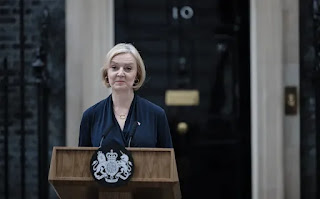The UK is stuck in a vicious cycle of stagnant growth and endless tax rises
Source - Daily Telegraph 27/10/22
The mini-Budget has been consigned to history. The tax cuts have been reversed. The architects of the experiment have been packed off to the back benches, and a sensible “grown-up” government has been restored.
The UK’s brief experiment with turbo-charging growth, or at least dragging it back up towards “mediocre”, has been brought to a swift and early conclusion.
By the time the new Chancellor Jeremy Hunt, and the new Prime Minister Rishi Sunak, deliver their hastily rescheduled fiscal statement in the middle of next month British economic policy will have been completely reset. It will be as if nothing had happened.
And yet that should not disguise one simple fact: Trussonomics may not have been the right answer, but at least it was addressing the right question.
If the country's political establishment can't recognise that, we are doomed to permanently lower growth, endlessly rising taxes, and a slow dimming of the country’s real potential.
True, there might have been lots of problems with the implementation of the programme: the communications were poor, and the reaction of the bond markets was underestimated.
And yet, it is also important to remember what it got right. Truss was right to diagnose that the UK economy is not in good shape, and hasn’t been for a long time.
We only look okay when compared to other failing European countries, with the same broken social model. Against the likes of the United States, Canada, Australia or South Korea we are falling further and further behind.
Growth has dropped below trend. Real wages have been stagnant for a decade and are now falling. The state ran up vast debts to pay for lockdowns that may not have been necessary, and then printed money to meet the bill.
Sure, there are other answers to all those problems. Perhaps re-joining the Single Market would lift growth, as Truss’s fiercest critics believe, but we were not doing very well when we were inside. Perhaps investing in “green energy” will lift the growth rate, especially if directed by a state-owned company.
And yet there is no real evidence that green jobs are better paid or more productive. Or perhaps better skills, greater equality, and better healthcare are the key. And yet it is not as if we haven’t been trying that for a quarter of a century, and so far the results are hard to see.
As the dust settles, the verdict on Liz Truss’s short-lived administration already seems settled. It was a catastrophic experiment in free-market, debt-fuelled, supply-side economics, inspired more by Ronald Reagan than Margaret Thatcher, which went disastrously off the rails as soon as it made its first contact with reality.
Its two main architects, Truss herself and her Chancellor Kwasi Kwarteng, couldn’t communicate, could hardly add up, and crumbled at the first signs of sustained opposition. It should never have been tried in the first place, and it never had any chance of working.
Over the last few days, it has thankfully been put firmly in the past, and we are back to where we were when Boris Johnson resigned as Prime Minister.
The pound is more or less back to its level in the spring. Gilt yields have fallen sharply, and so have fixed-rate mortgage deals, which matter a lot more to most of us.
Interest rates may not have to rise as much as was feared at the height of the crisis and, with the tax rises back in place, the Government will be able to get back to debating what it spends its vast budget on instead of how it might be trimmed. The whole brief farrago is safely over.
True, it is important to remember what went wrong with Trussonomics. The energy bailout was way too expensive, it was poorly targeted, and it should have come with a clearer explanation of how it was going to be paid for.
The Government did not do enough to prepare the financial markets about what was coming, nor to convince them that the pay-off from higher growth would be enough in and of itself to deal with a temporary rise in the deficit.
The timing, to put it mildly, was unfortunate. It was a difficult transformation to pull off at the best of times, but against the backdrop of rising inflation and an out-of-control dollar, it was doubly difficult.
Truss's programme did not have the necessary support within the Parliamentary Conservative Party either. Massive opposition from Labour, the Scottish Nationalists, and the Twitter mob was to be expected.
But very few MPs were willing to support the plan, and without that backing it was always going to be hard to push through. Even before it got on to the genuinely difficult stuff – investment zones, planning reform, the green belt – the opposition was overwhelming.
However, the real failure of Trussonmics may well have been the fault of the Bank of England. As Narayana Kocherlakota, a former President of the Minneapolis Fed, and now Professor of Economics at New York’s Rochester University, argued in an opinion piece for Bloomberg this week, it was the Bank’s failure to support the gilt market that killed the plan.
“The way the Truss government collapsed should concern all who support democracy,” he warned.
It will now be up to Rishi Sunak, and almost certainly very soon Sir Keir Starmer, to answer the question of how the UK will get back to the steady 2.5pc annual growth rate.
Once that rate would have been regarded as completely normal and it is the very minimum required if we are to have any hope of funding the kind of public services we expect with a steadily ageing population.
The Government has rejected one solution – but right now there are no signs of any answers of their own.

Comments
Post a Comment